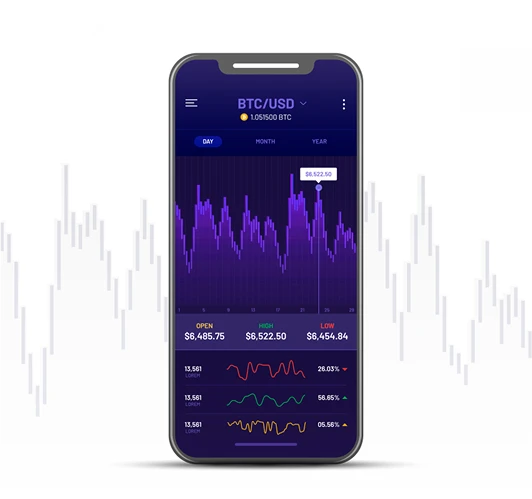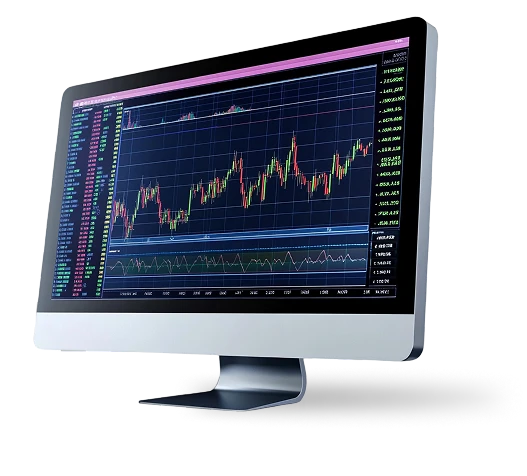Immutable Azopt offers a powerful yet accessible way to harness AI, simplifying the entire analysis process for both beginners and advanced traders. Its continuously running AI-driven system tracks price fluctuations in real time, offering immediate, reliable insights that support smarter trading decisions.
Immutable Azopt applies advanced machine learning to filter raw market data, detecting shifts in momentum and breaks in patterns influenced by crowd behavior. These insights allow users to plan based on concrete data rather than speculation. Keep in mind, cryptocurrency markets are highly volatile and may lead to financial losses.
With copy-trading features embedded in Immutable Azopt, users can follow strategies that have delivered strong results in the past while monitoring ongoing data. Industry-grade encryption, combined with Immutable Azopt's sleek interface and structured dashboards, promotes secure and confident engagement with digital assets.

Real-time pattern recognition enables Immutable Azopt to act swiftly in response to sudden market dynamics, providing crisp insights that refine observations, rank opportunities, and inform confident decision-making under pressure.

Offering real-time analytics, Immutable Azopt distills live data into meaningful, actionable insights, reducing guesswork and enabling systematic development of trade setups backed by verifiable signals.

Immutable Azopt constantly analyzes market shifts using advanced machine learning, highlighting key trends and offering actionable insights through a clean, user-friendly dashboard. As always, keep in mind that crypto markets are volatile and losses may occur.
With built-in copy-trading, around-the-clock monitoring, and a secure, intuitive design, Immutable Azopt makes it easy to follow successful strategies and stay informed—no matter your experience level.

Immutable Azopt is equipped with advanced encryption, routine security reviews, and transparent logging to safeguard every piece of user information—even in read-only or research mode. Its architecture ensures that insight discovery stays separate from trade activity, giving you a focused, secure space to strategize with confidence.
Immutable Azopt applies advanced machine learning to turn large market data into clear, actionable signals. Real-time updates help Immutable Azopt track sentiment and momentum shifts, supporting smarter strategies. Crypto markets are volatile, and losses may occur.
Immutable Azopt brings your data to life with interactive charts, heat maps, and personalized watchlists—making complex market movements easier to read. With real-time monitoring around the clock, you always have up-to-date insights at a glance.
Machine-learning pipelines inside Immutable Azopt are capable of detecting subtle flow changes, updating trade-ready insights in quasi-real time. The cryptocurrency markets are very volatile, and losses may occur; adaptive analyses keep their users on their toes.
Immutable Azopt runs 24/7, continuously tracking exchange feeds and on-chain metrics to cut through the noise. It filters out distractions and highlights real market shifts—so traders can spot meaningful price movements and momentum changes the moment they happen. With Immutable Azopt, you’re always a step ahead of emerging trends.
Getting started with Immutable Azopt is simple. The platform offers a guided help center with step-by-step walkthroughs and smart prompts, helping you navigate every feature with ease. Whether you're new to trading or a seasoned pro, Immutable Azopt makes the learning curve feel smooth and stress-free.
Immutable Azopt uses advanced AI to scan for volume spikes, order book shifts, and price action patterns—all in real time. It pinpoints trade opportunities down to the millisecond and adjusts instantly as market conditions change, keeping your strategies sharp and aligned.
The platform is equipped with a full support suite to keep your experience seamless. From interactive walkthroughs and in-app tutorials to searchable documentation, guidance is always within reach. New users can follow clear setup guides, while tooltips offer helpful explanations for advanced tools.
Immutable Azopt analyzes a wide range of crypto market signals to spot trend changes and identify the right moments to act. It takes complex, fast-moving data and turns it into clear, actionable insights—giving traders a better understanding of market conditions and helping improve timing.
To cut through the uncertainty, Immutable Azopt interprets shifting patterns as valuable signals. It alerts users to potential market moves before they happen, offering crucial lead time to plan and respond effectively.
Security is at the core of Immutable Azopt. With multiple layers of encryption and strict access controls, user data stays protected. Built on a solid and secure foundation, delivers reliable insights, strategic trading guidance, and consistent support—helping traders stay confident and informed in a fast-paced market.

When the market shifts quickly, Immutable Azopt provides a structured approach to help traders make timely decisions. Its customizable evaluation tools determine whether it’s the right time to enter or exit a position, based on real-time market signals. By combining short-term indicators with longer-term trends.
The platform’s advanced AI tracks live market data to spot exact windows of opportunity. With continuous updates and evolving scoring, Immutable Azopt adapts to each trader’s needs—helping refine decisions in real time as market conditions change.
Fast-moving markets call for speed, but lasting trends require a steady hand. Immutable Azopt helps you compare short-term trade setups with long-term strategies side by side—making it easier to see which approach fits the current market direction and momentum.
Thin order books can lead to higher slippage, while deeper markets offer more stable execution. Immutable Azopt tracks real-time trade activity and volume clusters to highlight liquidity hotspots. These insights help traders place orders when spreads are tighter and execution is more reliable.
Overexposure can jeopardize even the strongest strategies. Immutable Azopt sets exact risk bands using entry and exit thresholds. Once the price reaches these levels, custom alerts are activated so that users stay disciplined with stop-loss placement and position sizing based on objectives.
Real setups are so often blocked by heavy data noise. Immutable Azopt uses machine learning to filter out irrelevant spikes. By preventing alerts for anything lacking statistical significance, such attention can be best reserved for trades on which one can have a high degree of confidence.

Immutable Azopt brings together trusted tools like MACD, Fibonacci levels, and the Stochastic Oscillator to help you break down price movements and spot developing trends.
These indicators work together to highlight key support and resistance zones, detect momentum changes, and flag potential overbought or oversold conditions—without emotion or guesswork.
By combining multiple signals, Immutable Azopt simplifies complex charts into clear, actionable alerts—so you can make confident, data-backed decisions when entering or exiting trades.
Immutable Azopt utilizes natural language processing to analyze social media, news headlines, and forums, converting everyday market chatter into actionable sentiment scores. By analyzing positive and negative language, it helps track whether the overall mood is leaning more toward optimism or caution.
When Immutable Azopt picks up a rise in bullish talk or a wave of nervous sentiment, it sends out early alerts—often before those feelings start to show in price charts. These timely signals serve as emotional warning signs, enabling traders to spot potential reversals or breakout moments before the rest of the market catches up.
Inside Immutable Azopt, sentiment data is combined with momentum and volume indicators to provide a more comprehensive picture. This layered view helps traders understand how emotional trends either support or challenge technical signals, providing them with both the market's mindset and the hard numbers to back up every move.

Shifts in inflation trends, interest rate changes by central banks, and employment reports often trigger sharp, sudden movements in the cryptocurrency market. Immutable Azopt analyzes these macroeconomic signals in detail, breaking down complex data into clear, practical insights.
New tax laws or regulatory updates can also cause markets to swing fast. Immutable Azopt examines how similar policy changes have impacted prices in the past, enabling users to draw beneficial connections and anticipate where the market may head next.
By identifying recurring patterns in global data, Immutable Azopt enables users to plan both short-term trades and long-term investment strategies. The combination of economic principles with AI-driven analysis provides traders with a stronger foundation for navigating today’s rapidly changing cryptocurrency environment.

Successful trading hinges on knowing exactly when to enter or exit. Immutable Azopt uses advanced machine learning to spot early signs of reversals, breakouts, and unusual price movements—so you can act on data, not emotion.
By constantly tracking momentum, volume, and price levels, Immutable Azopt provides real-time signals to help traders make sharper, more informed decisions when it matters most.
Similarly, diversified exposure to multiple digital assets tends to reduce portfolio volatility. Comparative analysis by Immutable Azopt across various tokens reveals how different configurations behave in different market conditions. This facilitates the structuring of asset allocations that can withstand.
Early reversals often mean subtle shifts before trend-wise changes occur. Immutable Azopt watches micro price movements and on-chain activity from these inflection points. Instant alerts enable traders to capitalize on late market changes that precede broader sentiment shifts.
Small bursts of sharp momentum signify the phases of breakout. Immutable Azopt detects surges in price spikes based on volume indicators and then sends out accurate alerts accordingly. Traders can then adjust their strategies in response to the evolution of these momentum patterns.
As uncertainty sets in with explosive volatility, confusion crumbles wise judgment. Immutable Azopt condenses giant market data sets into concise, structured reports, identifying causal drivers and probabilistic scenarios. This clarity absorbs trading emotions, allowing traders to own the price while it rapidly fluctuates.
Large language models and algorithmic pattern detectors sift through enormous amounts of market data to bring into light emerging trading setups. Immutable Azopt filters away irrelevant data to pinpoint lucrative entry and exit zones that come about through a structured collision of rule-based screening and adaptive analytics.
This harmonious interlacing of automated analysis and strategically structured approach converts buzzwords of live price action into actionable guidance to execute in chorus through phases of the market. With Immutable Azopt, strategies are continuously being reshaped in real-time to ensure signals are perfectly aligned with emerging trends.
| 🤖 Sign-Up Cost | Registration free of charge |
| 💰 Fee Structure | Completely fee-free |
| 📋 Method of Registration | Simple and expedient signup process |
| 📊 Educational Content | Focuses on Digital Currency, Stock Market, and other Financial Instruments |
| 🌎 Market Coverage | Covers most countries but does not include the USA |